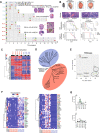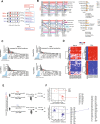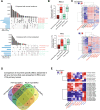Epigenetic Alterations of Repeated Relapses in Patient-matched Childhood Ependymomas
- PMID: 36335125
- PMCID: PMC9637194
- DOI: 10.1038/s41467-022-34514-z
Epigenetic Alterations of Repeated Relapses in Patient-matched Childhood Ependymomas
Erratum in
-
Publisher Correction: Epigenetic alterations of repeated relapses in patient-matched childhood ependymomas.Nat Commun. 2022 Dec 22;13(1):7871. doi: 10.1038/s41467-022-35539-0. Nat Commun. 2022. PMID: 36550163 Free PMC article. No abstract available.
Abstract
Recurrence is frequent in pediatric ependymoma (EPN). Our longitudinal integrated analysis of 30 patient-matched repeated relapses (3.67 ± 1.76 times) over 13 years (5.8 ± 3.8) reveals stable molecular subtypes (RELA and PFA) and convergent DNA methylation reprogramming during serial relapses accompanied by increased orthotopic patient derived xenograft (PDX) (13/27) formation in the late recurrences. A set of differentially methylated CpGs (DMCs) and DNA methylation regions (DMRs) are found to persist in primary and relapse tumors (potential driver DMCs) and are acquired exclusively in the relapses (potential booster DMCs). Integrating with RNAseq reveals differentially expressed genes regulated by potential driver DMRs (CACNA1H, SLC12A7, RARA in RELA and HSPB8, GMPR, ITGB4 in PFA) and potential booster DMRs (PLEKHG1 in RELA and NOTCH, EPHA2, SUFU, FOXJ1 in PFA tumors). DMCs predicators of relapse are also identified in the primary tumors. This study provides a high-resolution epigenetic roadmap of serial EPN relapses and 13 orthotopic PDX models to facilitate biological and preclinical studies.
© 2022. The Author(s).
Conflict of interest statement
M.L., P.G., A.-C.V., S.S., and G.B. were employees of Epigenetic Services, Diagenode, Liège, Belgium. The remaining authors declare no competing interests.
Figures





References
-
- Ritzmann, T. A. et al. A retrospective analysis of recurrent pediatric ependymoma reveals extremely poor survival and ineffectiveness of current treatments across central nervous system locations and molecular subgroups. Pediatr. Blood Cancer10.1002/pbc.28426 (2020). - PubMed
Publication types
MeSH terms
Substances
Supplementary concepts
Grants and funding
LinkOut - more resources
Full Text Sources
Miscellaneous

